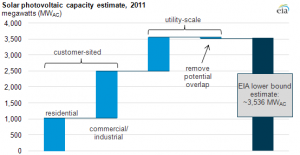In order for the public to use renewable energy (in this case, solar PV), it would be necessary for the renewable energy source be connected to the utility grid in order to reach the customers. In the US, the solar PV capacity is rapidly growing as the amount of solar panels have been increasing. One of the challenges with collecting statistics is that not all solar PV energy reaches consumers via the grid. people obtain their own solar panels and therefore simply get power from their panels at their own locations (ex: rooftop solar panels) rather than a centralized sources. In order to estimate the total PV technology, there has to be several accounts. EIA maintains an inventory of power plants that has a capacity of at least one megawatt while having difficulties gathering census information regarding the number of residential and commercial PV installations throughout the US. [1]
Image source: EIA
However, rooftop panels do not provide enough electricity for a home’s entire power needs, as it is unable to get sunlight during night time and non-sunny days. Therefore, the rest of the power comes from the grid. Although consumers still pay less for the utility cost, they still must provide payment for the utility services; utilities should, in exchange, simplify the process of providing connections to the grid. Utility services must also pay the owners “fairly for the services they provide.” There is a current policy where utilities must purchase excess electricity that is generated by customers’ solar panels; this is called “net metering.” Both groups hope for this policy would continue with some improvements, whereas a new mechanism would cover the fixed costs for utilities. [2]
Primary Author: Amos Han
Primary Editor: Joe Donatoni
